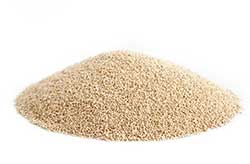Yeast is an incredibly versatile microorganism that plays a crucial role in baking, brewing, and other fermentation processes. But is yeast an animal? This question often confuses people because yeast behaves somewhat like an organism in the animal kingdom, but it isn’t one. In this article, we’ll dive deep into yeast’s classification, characteristics, and why it isn’t classified as an animal.

What is Yeast?
Yeast and Its Biological Classification
Yeast vs. Animals: What’s the Difference?
Yeast's Role in Ecosystems
How Yeast Reproduces
Yeast in Baking and Brewing
Can Yeast Be Considered a Microorganism?
Conclusion: Yeast’s Place in the Living World
Yeast is a type of fungus that is made up of single-celled organisms. It is found in a variety of environments, from soil to the surfaces of fruits, and is often used in baking, brewing, and winemaking. The most well-known type of yeast is Saccharomyces cerevisiae, which is used in the production of bread and alcoholic beverages. Yeast helps in fermentation, a process where it breaks down sugars into alcohol and carbon dioxide.
In the simplest terms, yeast is a microorganism that plays an important role in many industrial and natural processes. It is vital for food production and acts as a natural decomposer in the ecosystem.
Yeast belongs to the Fungi Kingdom . It is important to note that while yeast is alive and has a complex structure, it is not an animal. Animals belong to a completely different kingdom known as Animalia, which includes multicellular organisms that are primarily heterotrophic (relying on external sources for food).
Yeast, on the other hand, is a single-celled organism and is classified as a eukaryote . This means that, like animals and plants, yeast has a well-defined nucleus containing its genetic material, which sets it apart from bacteria (which are prokaryotes with no nucleus).
Now, let’s address the core question: Is yeast an animal?
Animals: Animals are multicellular, often complex organisms that can move, respond to stimuli, and typically have specialized organs. They are part of the Animalia Kingdom and can be either warm-blooded (like humans) or cold-blooded (like reptiles).
Yeast: Yeast is a single-celled organism, which means it doesn’t have the complex organs, tissues, or systems that animals do. It is part of the Fungi Kingdom and does not exhibit behaviors like movement, hunting, or responding to stimuli the way animals do.
Essentially, yeast is very different from animals in terms of structure, function, and biological classification, making it clear that yeast is not an animal.
In nature, yeast plays a vital role in breaking down organic materials. As decomposers, they help break down dead plants and animals into simpler compounds, which enrich the soil and contribute to the nutrient cycle. Yeast is a key player in the natural process of decomposition.
In the world of fermentation, yeast helps transform sugars from fruits and plants into alcohol and carbon dioxide. This is why it is such an important organism in both the food and beverage industries. Without yeast, we wouldn’t have beer, wine, or bread in the same way we know them today.
Yeast can reproduce in two main ways: asexual reproduction through budding and sexual reproduction under certain conditions.
Budding: The most common method is asexual reproduction, known as budding. In this process, a new yeast cell forms as a small bud on the parent cell and eventually detaches to live independently. This is a very efficient way for yeast to multiply.
Sexual Reproduction: In more stressful conditions, yeast can also reproduce sexually. This process involves two yeast cells merging to form a new cell with a different genetic combination. Sexual reproduction can help yeast adapt to changes in its environment.
These reproduction methods make yeast incredibly adaptable, allowing it to survive in diverse environments.
Yeast has been used by humans for thousands of years to make bread, beer, and wine. In baking, yeast helps dough rise by fermenting sugars and producing carbon dioxide gas, which causes the dough to expand. In brewing and winemaking, yeast ferments sugars to produce alcohol, contributing to the flavor and alcohol content of the beverages.
The role of yeast in baking and brewing is a perfect example of how a microorganism can be used for practical purposes in human culture. Without yeast, many of the foods and drinks we love would not exist.
Yes, yeast is considered a microorganism because it is so small that it can only be seen under a microscope. Microorganisms include a variety of organisms like bacteria, fungi, viruses, and algae. Yeast, being a single-celled fungus, fits neatly into the category of microorganisms, playing a critical role in ecosystems and human industry alike.
In conclusion, yeast is not an animal. It is a single-celled fungus that belongs to the kingdom Fungi, not Animalia. While it shares some similarities with animals, such as being a eukaryote, its classification and characteristics make it distinct from animals. Yeast is incredibly important in both natural ecosystems and human industries like baking and brewing. It contributes to decomposition and fermentation, making it a key player in various ecological and economic processes.
So, the next time you enjoy a slice of bread or a cold glass of beer, remember to thank yeast for its hard work in the background!
Understanding yeast’s role and classification helps us better appreciate this tiny organism that has a huge impact on both nature and human culture. While it may not be an animal, yeast is far from ordinary. It is a versatile, essential microorganism that deserves recognition for its contributions to our world.
animal tags: yeast
We created this article in conjunction with AI technology, then made sure it was fact-checked and edited by a Animals Top editor.